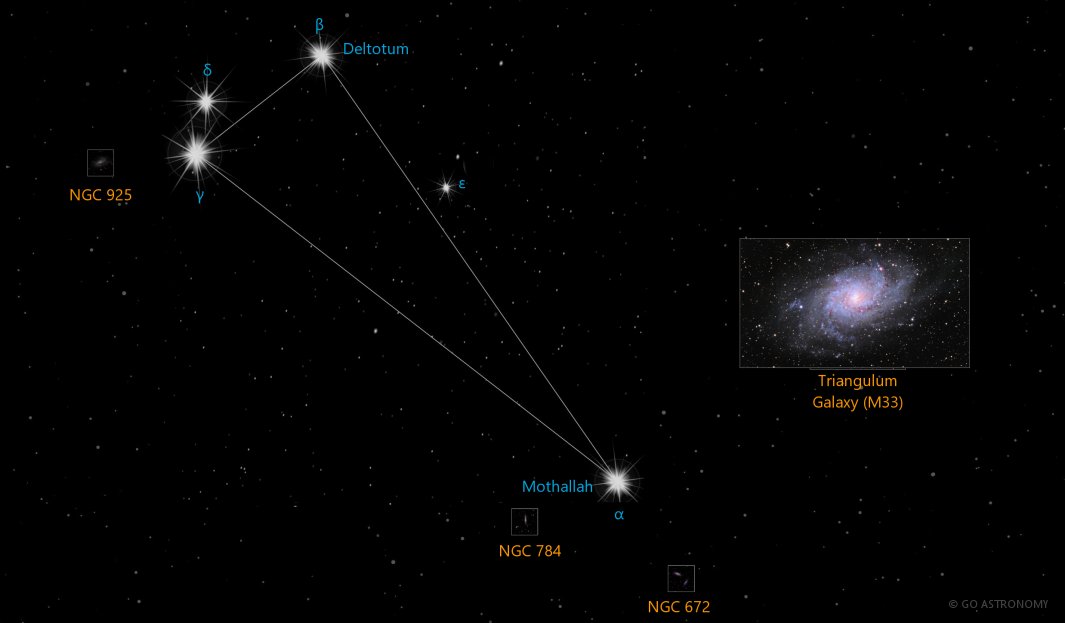Triangulum, the Triangle (Tri)
(try-ANG-you-lum)
The Northern constellation of Triangulum, the Triangle, is best viewed in Winter during the month of December.
Triangulum is the 78th largest constellation. It's brightest star is Beta Trianguli at magnitude 3.00. The boundary of the Triangulum constellation contains 3 stars that host known exoplanets.
- Pronunciation:
- try-ANG-you-lum
- Meaning:
- Triangle
- Genitive:
- Trianguli
- Abbreviation:
- Tri
- Constellation Family:
- Perseus
- Hemisphere:
- Northern
- Quadrant:
- NQ1
- Visibility:
- 90° N - 60° S
- Best viewing month*:
- December
- Area:
- 132 sq. degrees
- Size:
- 78th largest
- Right Ascension (avg):
- 2h 3m
- Declination (avg):
- 32°
- Brightest star:
- Beta Trianguli (3.00)
- Stars with planets:
- 3
- Caldwell objects:
- |
Brightest Stars in Triangulum
The 10 brightest stars in the constellation Triangulum by magnitude.
- Star
- Magnitude
- Spectral class
- Beta Trianguli (β Tri)
- 3
- A5III
- Alpha Trianguli (α Tri)
- 3.42
- F6IV
- Gamma Trianguli (γ Tri)
- 4.03
- A1Vnn
- Delta Trianguli (δ Tri)
- 4.84
- G0V
- Iota Trianguli (ι Tri)
- 4.94
- F5V comp SB
- 14 Trianguli (14 Tri)
- 5.15
- K5III
- 7 Trianguli (7 Tri)
- 5.25
- A0V
- 10 Trianguli (10 Tri)
- 5.29
- A2V
- 12 Trianguli (12 Tri)
- 5.29
- F0III
- 15 Trianguli (15 Tri)
- 5.38
- M3III
Double Stars in Triangulum
These are the brightest and easiest-to-find double, triple, and quadruple star systems in the constellation Triangulum. Also see all star clusters.
- Star system
- Magnitudes
- Type
- Iota Trianguli
- 5.3, 6.7
- double
Galaxies in Triangulum
The most notable galaxies in the constellation Triangulum. Also see all galaxies.
Milky Way Satellites in Triangulum
Dwarf satellite galaxies that orbit the Milky Way Galaxy located in the constellation Triangulum. Also see all Milky Way satellite galaxies.
- Galaxy name
- Alt name
- Magnitude
- Triangulum II
Black Holes in Triangulum
These are the most well-known smaller (non-supermassive) black holes in the constellation Triangulum. Although black holes cannot be seen directly, the smaller ones are at the center of some star clusters and supernova remnant nebulae, which can be seen. Supermassive black holes are at the center of most galaxies, such as Sagittarius A* at the center of our Milky Way galaxy. Also see all black holes.
- Black hole
- Type
- M33 X-7
- stellar
A Trip Through The Celestial Triangle
Triangulum, the Latin word for "triangle", is a small constellation in the northern sky. Its simplistic three-star shape and richness in celestial bodies make it an interesting area of study for both amateur and professional astronomers.
Historical Context
Triangulum is one of the 48 constellations listed by the 2nd-century Greek astronomer Ptolemy in his work, the Almagest. It has remained part of the modern list of 88 constellations defined by the International Astronomical Union (IAU). The constellation's simple shape and early recording indicate that it has been recognized as a distinct constellation for many centuries, possibly even pre-dating Ptolemy's era.
Location and Key Characteristics
Located in the second quadrant of the Northern hemisphere (NQ2), Triangulum is bordered by the constellations Andromeda, Aries, and Pisces. Covering a relatively small area of 132 square degrees, it ranks 78th in size among the 88 modern constellations.
The brightest star in Triangulum, Beta Trianguli, is a white star of spectral type A5 with a magnitude of 3.00. It lies approximately 127 light-years away from us. The constellation does not contain any Messier objects and does not serve as the radiant for any meteor showers.
Celestial Objects of Interest
Despite its modest size and lack of bright stars, Triangulum is home to several interesting celestial objects, the most notable being the Triangulum Galaxy (M33). This spiral galaxy is one of the most distant permanent objects that can be viewed with the naked eye under dark sky conditions. As the third-largest member of the Local Group, following the Andromeda Galaxy (M31) and the Milky Way, M33 is approximately 3 million light-years away from us.
Another object of interest is NGC 604, one of the largest known H II regions, located within the Triangulum Galaxy. An H II region is a large cloud of partially ionized gas in which star formation has recently taken place. NGC 604 is an important object of study in the field of stellar birth and evolution.
Furthermore, the constellation hosts several variable stars, such as Delta Trianguli, a binary star system composed of two yellow dwarfs, and R Trianguli, a Mira-type variable star.
Observation
Triangulum can be observed from August through January and is most prominent in the evening sky in November. As it contains the easily recognizable asterism of three stars forming a long, narrow triangle, even inexperienced stargazers should have little trouble finding it. Although viewing the Triangulum Galaxy requires excellent sky conditions, it is well worth the attempt for the opportunity to observe one of our galactic neighbors.
* Constellation shown for northen hemisphere skies. For the southern hemisphere, constellations appear rotated 180 degrees (upside-down and left-right reversed) from what is shown. Remember that seasons are reversed too - summer in northern latitudes is winter in southern latitudes.
** Circumpolar constellations are visible year-round in the hemisphere listed (and not at all in the opposite hemisphere).





